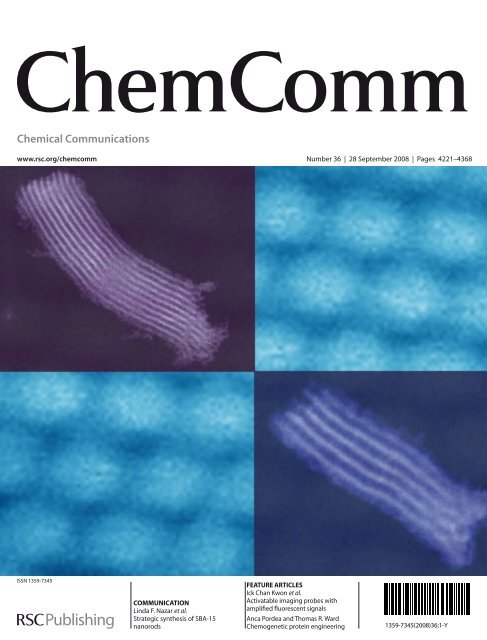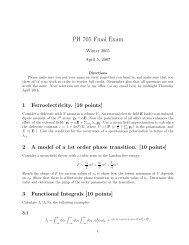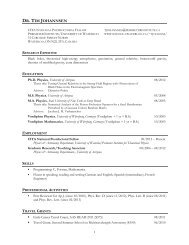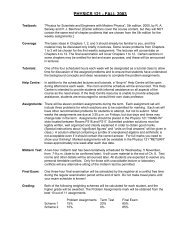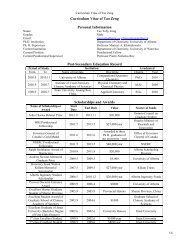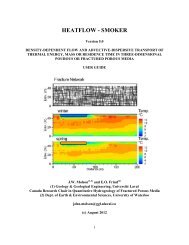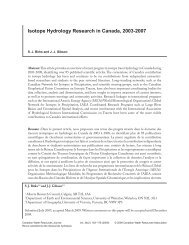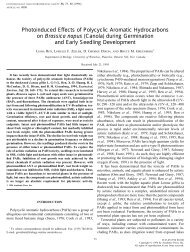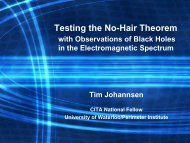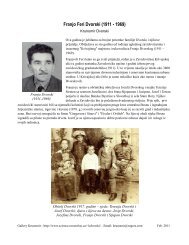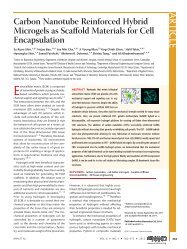Chem. Commun., 36, 4288-4290 - University of Waterloo
Chem. Commun., 36, 4288-4290 - University of Waterloo
Chem. Commun., 36, 4288-4290 - University of Waterloo
You also want an ePaper? Increase the reach of your titles
YUMPU automatically turns print PDFs into web optimized ePapers that Google loves.
<strong>Chem</strong>ical <strong>Commun</strong>ications<br />
www.rsc.org/chemcomm Number <strong>36</strong> | 28 September 2008 | Pages 4221–4<strong>36</strong>8<br />
ISSN 1359-7345<br />
COMMUNICATION<br />
Linda F. Nazar et al.<br />
Strategic synthesis <strong>of</strong> SBA-15<br />
nanorods<br />
FEATURE ARTICLES<br />
Ick Chan Kwon et al.<br />
Activatable imaging probes with<br />
amplified fluorescent signals<br />
Anca Pordea and Thomas R. Ward<br />
<strong>Chem</strong>ogenetic protein engineering<br />
1359-7345(2008)<strong>36</strong>;1-Y
COMMUNICATION<br />
www.rsc.org/chemcomm | <strong>Chem</strong>Comm<br />
Strategic synthesis <strong>of</strong> SBA-15 nanorodsw<br />
Xiulei Ji, Kyu T. Lee, Muguette Monjauze and Linda F. Nazar*<br />
Received (in Cambridge, UK) 19th March 2008, Accepted 14th May 2008<br />
First published as an Advance Article on the web 20th June 2008<br />
DOI: 10.1039/b804327b<br />
A simple synthesis <strong>of</strong> homogeneously sized, ordered mesoporous<br />
silica nanorods (SBA-15), spanning about 10 porous channels in<br />
width and ranging from 300 to 600 nm in length is reported.<br />
Periodic mesoporous materials have sparked great research<br />
interest since the discovery <strong>of</strong> the M41S family, 1 and extensive<br />
efforts have been devoted to their morphological control. 2<br />
Recently, increasing attention has focused on controlling the<br />
morphology <strong>of</strong> SBA-15. This material has many highly desirable<br />
characteristics such as an adjustable large pore size,<br />
sturdy walls and an interconnected quasi-2D hexagonal mesostructure<br />
(p6mm). 3 Many forms <strong>of</strong> mesoporous silicates<br />
closely related to SBA-15 have been obtained by utilizing<br />
block copolymers as templates, including fibers, 4 spheres, 5<br />
crystals, 6 monoliths, 7 and ultra-thin platelets. 8 To render the<br />
pores <strong>of</strong> SBA-15 more accessible for guest molecules in various<br />
applications, it is crucial to decrease its particle size to shorten<br />
the diffusion path length. Discrete rod-like particles <strong>of</strong> SBA-15<br />
(ca. 1.5 1 mm) have been obtained in the presence <strong>of</strong> KCl by<br />
Zhao et al. 9 Sayari et al. have introduced an elegant synthesis<br />
<strong>of</strong> monodispersed SBA-15 rods with uniform size (ca. 1.5 <br />
0.4 mm) under static conditions without any additives, 10<br />
although the mechanism <strong>of</strong> particle size control was not<br />
detailed. The particle growth process has been examined by<br />
several in situ techniques that probe the mechanism. According<br />
to these studies, wormlike nano-domains are proposed to<br />
form first, which then interconnect into larger particles (more<br />
than 1 mm) after a period <strong>of</strong> time (60 to 100 min). 11–13<br />
Nonetheless, almost all syntheses <strong>of</strong> SBA-15 in the past decade<br />
were carried out with a similar P123 (EO 20 PPO 70 EO 20 ) concentration<br />
in the reaction mixture <strong>of</strong> 2.5–3 wt%. Here, we<br />
present a simple synthesis <strong>of</strong> SBA-15 nanodimensioned rods<br />
(ca. 0.5 0.1 mm) that employs a dilute solution <strong>of</strong> P123 and<br />
TEOS in an acidic aqueous medium under static conditions<br />
without any additives. This enables us to halt the synthesis at<br />
the initial stage in the nucleation and growth mechanism, and<br />
thus trap nanorods with particle sizes many orders <strong>of</strong> magnitude<br />
smaller than previously reported. Our studies moreover<br />
lend strong support to the proposed microstructure evolution<br />
theories based on cryo-TEM, and SAXS/XRD studies. 11–13<br />
In a typical synthesis, 2 g <strong>of</strong> Pluronic P123 were dissolved in<br />
<strong>36</strong>0 ml <strong>of</strong> 2 M HCl at 38 1C. Tetraethyl orthosilicate (TEOS,<br />
4.2 g) was added into the above solution with vigorous<br />
stirring. The concentrations <strong>of</strong> P123 and TEOS in the solution<br />
<strong>University</strong> <strong>of</strong> <strong>Waterloo</strong>, Department <strong>of</strong> <strong>Chem</strong>istry, <strong>Waterloo</strong>, Ontario,<br />
Canada N2L 3G1. E-mail: lfnazar@uwaterloo.ca<br />
w Electronic supplementary information (ESI) available: Experimental<br />
details. See DOI: 10.1039/b804327b<br />
were 0.53 wt% and 1.1 wt%, respectively, B1/5 <strong>of</strong> those in<br />
conventional syntheses <strong>of</strong> SBA-15 reported in the literature.<br />
10–13 The mixture was stirred for 6 min and remained<br />
quiescent for 24 h at 38 1C. It was subsequently heated at<br />
100 1C for another 24 h in an autoclave. The as-synthesized<br />
SBA-15 was collected by centrifugation, dried and calcined at<br />
550 1C in air (yield: 91% based on Si). A series <strong>of</strong> varying<br />
concentrations <strong>of</strong> P123 and TEOS in 2 M HCl were prepared,<br />
with the ratio between P123 and TEOS kept the same as<br />
above. These were 1/1, 2/5, 1/5, and 1/10 <strong>of</strong> the concentrations<br />
<strong>of</strong> P123 and TEOS employed in a conventional synthesis <strong>of</strong><br />
SBA-15. We refer to these SBA-15 materials as SBA15-1/1,<br />
SBA15-1/2.5, SBA15-1/5, and SBA15-1/10.<br />
The declining trend in particle size along the series from<br />
SBA15-1/1 to SBA15-1/5 is evident in the microscopy images<br />
shown in Fig. 1a–d, and from the data summarized in Table 1.<br />
SBA15-1/5 exhibits the smallest particle size along with very<br />
uniform morphology, shown in the scanning electron microscopy<br />
(SEM) image (Fig. 1a). A survey <strong>of</strong> the entire sample<br />
revealed a remarkably homogeneous particle size distribution<br />
that was confirmed by particle size analysis. The diameter <strong>of</strong><br />
the rods is less than 100 nm, almost 1/15 <strong>of</strong> SBA15-1/1<br />
Fig. 1 SEM images <strong>of</strong> (a) SBA15-1/5, (c) SBA15-1/2.5, (d) SBA15-1/1<br />
recorded on a LEO 1530 field emission SEM instrument, and TEM<br />
images <strong>of</strong> SBA15-1/5, (b) and (e) recorded on a Hitachi HD-2000<br />
STEM.<br />
<strong>4288</strong> | <strong>Chem</strong>. <strong>Commun</strong>., 2008, <strong>4288</strong>–<strong>4290</strong> This journal is c The Royal Society <strong>of</strong> <strong>Chem</strong>istry 2008
Table 1<br />
Physical characteristics <strong>of</strong> mesoporous silicate samples<br />
Samples Dimensions/mm S BET /m 2 g 1 V p /cm 3 g 1 Pore size/nm d 100 spacing/nm Wall thickness/nm<br />
SBA15-1/1 ca. 1.5 1.2 601 0.83 5.4 8.6 4.5<br />
SBA15-1/2.5 ca. 0.8 0.5 769 1.06 6.3 10.2 5.4<br />
SBA15-1/5 ca. 0.5 0.1 619 1.13 6.2 10.5 5.9<br />
SBA15-1/10 ca. 0.5 0.1 479 0.73 6.5 10.8 6.0<br />
Calcined SBA15-1/5 at 900 1C ca. 0.5 0.1 217 0.39 4.3 9.6 6.7<br />
Calcined SBA15-1/1 at 900 1C ca. 1.5 1.2 35 0.15 N/A N/A N/A<br />
(Fig. 1d). Each nanorod thus spans only B10 mesoporous<br />
silica channels. The length <strong>of</strong> the rods ranges from 300 nm<br />
to 600 nm. Even though the particle size is dramatically<br />
decreased, SBA15-1/5 still exhibits highly ordered hexagonal<br />
(P6mm) symmetry, as seen in the powder X-ray diffraction<br />
(XRD) pattern (Fig. 2a,ii) and the transmission electron<br />
microscopy (TEM) image (Fig. 1b). The ordered channels<br />
are oriented along the long axis <strong>of</strong> the rod. The morphology<br />
<strong>of</strong> SBA15-1/10 is quite similar to that <strong>of</strong> SBA15-1/5. SBA15-<br />
1/10, prepared with extremely low concentrations <strong>of</strong> P123 and<br />
TEOS, also still exhibits long range order, as shown by the<br />
XRD pattern (Fig. 2a,iii). This is in contrast to previous<br />
reports that claimed when the concentration <strong>of</strong> copolymer is<br />
lower than 0.5 wt%, only amorphous silica is formed. 3 Similar<br />
to nanocrystals with short range order, smaller particles with<br />
long range order will also result in less well defined X-ray<br />
Fig. 2 (a) XRD patterns <strong>of</strong> (i) SBA15-1/1, (ii) SBA15-1/5,<br />
(iii) SBA15-1/10; (b) N 2 adsorption–desorption isotherm for SBA15-<br />
1/5. (Inset) Pore size distribution <strong>of</strong> SBA15-1/5.<br />
diffraction peaks since the effective coherence length is reduced.<br />
14 An estimate <strong>of</strong> the width <strong>of</strong> the SBA15-1/5 nanocrystallite<br />
rods (i.e., domain size) was obtained from analysis <strong>of</strong><br />
the first reflection in the XRD pattern (100) using the Scherrer<br />
equation. The calculated dimension was 87 nm, in excellent<br />
accord with the rod width observed in the TEM images <strong>of</strong><br />
about 90 nm (Fig. 1b and e) that spans an average <strong>of</strong> 10<br />
porous channels. The corresponding value for SBA15-1/10<br />
was only 49 nm. This follows the same trend as the particle size<br />
observed in TEM, and further supports our claim <strong>of</strong> the order<br />
being preserved even at these extremely small length scales.<br />
The slower rate <strong>of</strong> nucleation and growth in dilute solution<br />
has an effect on the physical characteristics <strong>of</strong> the materials.<br />
Nitrogen adsorption and desorption isotherms were measured<br />
for calcined samples, and a typical curve is shown in Fig. 2b<br />
for SBA15-1/5. The pore size was determined from the desorption<br />
branch, and the resultant physical characteristics <strong>of</strong> the<br />
samples are presented in Table 1. The pore dimensions <strong>of</strong> all <strong>of</strong><br />
the series (5.4–6.2 nm) are typical <strong>of</strong> SBA-15. 3 Compared to<br />
SBA15-1/1, all <strong>of</strong> the series SBA15-1/2.5, SBA15-1/5 and<br />
SBA15-1/10 have a larger d-spacing and pore size, and thicker<br />
walls, the latter being presumably a result <strong>of</strong> the slower rate<br />
process during nucleation. We note that the calculated wall<br />
thickness <strong>of</strong> SBA15-1/5 is consistent with estimation from the<br />
TEM images. As a consequence, SBA15-1/5 also exhibited<br />
better thermal stability compared to SBA15-1/1. After calcination<br />
at 900 1C for 2 h, SBA15-1/5 still maintained appreciable<br />
surface area, pore volume and long range order, the latter<br />
being confirmed by well defined peaks in the XRD pattern. In<br />
contrast, SBA15-1/1 suffered pore collapse. The characteristics<br />
<strong>of</strong> the high temperature calcined samples are shown in Table 1.<br />
We believe that the key to control the particle size <strong>of</strong><br />
mesoporous silicates is to minimize the chances <strong>of</strong> collision<br />
<strong>of</strong> the nano-domains formed at an early stage <strong>of</strong> cooperative<br />
assembly/condensation. Fig. 3 depicts the difference between<br />
the conventional case and the highly dilute case in terms <strong>of</strong> the<br />
degree <strong>of</strong> particle growth. In a highly dilute reaction environment,<br />
the newly formed wormlike nano-domains are kinetically<br />
inhibited from forming larger agglomerates. This is<br />
evident in Fig. 1e, where only a few particles are partially<br />
connected end to end (inset a) and side to side (inset b). This<br />
indicates that the merging <strong>of</strong> these nanorods is not complete<br />
even under hydrothermal conditions owing to the slower rate<br />
<strong>of</strong> nucleation and growth. The very small particle size gives<br />
rise to formation <strong>of</strong> a stable, completely non-settling milky<br />
suspension 1 2<br />
h after the TEOS was added, necessitating<br />
material recovery by centrifugation. Under conventional conditions,<br />
the nano-domains are closely distributed and rapidly<br />
agglomerate into large particles owing to driving forces that<br />
minimize surface free energy. In accord, for SBA15-1/1 and<br />
This journal is c The Royal Society <strong>of</strong> <strong>Chem</strong>istry 2008 <strong>Chem</strong>. <strong>Commun</strong>., 2008, <strong>4288</strong>–<strong>4290</strong> | 4289
especially important for catalytic inorganic oxide materials<br />
that rely on short diffusion lengths, 16,17 and replica template<br />
mesoporous materials. These have applications such as conductive<br />
scaffolds to encapsulate materials for electrodes in Li<br />
ion batteries, more efficient catalyst support materials for<br />
PEM fuel cells, and absorption materials for toxic hydrophobic<br />
organic molecules for environmental protection. Further<br />
work is ongoing in our laboratory to explore such materials.<br />
LFN thanks NSERC (Canada) for its generous support<br />
through the Discovery Grant program.<br />
Fig. 3 Schematic diagram depicting the influence <strong>of</strong> dilution <strong>of</strong><br />
reaction solution on particle growth. (A) conventional synthesis,<br />
(B) highly dilute case.<br />
SBA15-1/2.5, the cloudy suspension appeared in half the time<br />
after the addition <strong>of</strong> TEOS, followed by rapid precipitation.<br />
In summary, we have prepared and characterised mesoporous<br />
silica with a novel nano-rod morphology. To our<br />
knowledge, this is the first example <strong>of</strong> such a confined organization<br />
<strong>of</strong> silica channels, whose formation under the controlled<br />
conditions we have implemented supports previously<br />
proposed mechanisms <strong>of</strong> growth and nucleation. We note that<br />
hexagonal platelets <strong>of</strong> amino functionalised SBA-15 with short<br />
1D channels have also been realised by chemical modification.<br />
15 According to our preliminary results, this dilution<br />
strategy can be applied to other syntheses <strong>of</strong> mesostructured<br />
materials employing amphiphilic molecules and/or copolymers<br />
as structure directing agents. We will report those results<br />
in a forthcoming paper. The concept <strong>of</strong> controlled assembly <strong>of</strong><br />
precursors to form nanotubes is also believed to be responsible<br />
for the the synthesis <strong>of</strong> ultra-short (B20 nm) aluminiumgermanium-hydroxide<br />
nanotubes under pH control. 16 The<br />
decrease <strong>of</strong> rod diameter/lengths to nanodimensions is<br />
Notes and references<br />
1 C. T. Kresge, M. E. Leonowicz, W. J. Roth, J. C. Vartuli and<br />
J. S. Beck, Nature, 1992, 359, 710.<br />
2 H. Yong, N. Coombs and G. Ozin, Nature, 1997, 386, 692.<br />
3 D. Zhao, J. Feng, Q. Huo, N. Melosh, G. H. Fredrickson,<br />
B. F. Chmelka and G. D. Stucky, Science, 1998, 279, 548.<br />
4 P. Yang, D. Zhao, B. Chmelca and G. D. Stucky, <strong>Chem</strong>. Mater.,<br />
1998, 10, 2033.<br />
5 C. Boissiere, A. Larbot, A. van der Lee, P. J. Kooyman and<br />
E. Prouzet, <strong>Chem</strong>. Mater., 2000, 12, 2902.<br />
6 C. Yu, B. Tian, J. Fan, G. D. Stucky and D. Zhao, J. Am. <strong>Chem</strong>.<br />
Soc., 2002, 124, 4556.<br />
7 P. Feng, X. Bu, G. D. Stucky and D. J. Pine, J. Am. <strong>Chem</strong>. Soc.,<br />
2000, 122, 994.<br />
8 Q. Hu, R. Kou, J. Pang, T. Ward, M. Cai, Z. Yang, Y. Lu and<br />
J. Tang, <strong>Chem</strong>. <strong>Commun</strong>., 2007, 601.<br />
9 C. Yu, J. Fan, B. Tian and D. Zhao, <strong>Chem</strong>. Mater., 2004, 16, 889.<br />
10 A. Sayari, B. Han and Y. Yang, J. Am. <strong>Chem</strong>. Soc., 2004, 126,<br />
14348.<br />
11 K. Flodstro¨m, C. Teixeira, H. Amenitsch, V. Alfredsson and<br />
M. Lindén, Langmuir, 2004, 20, 4885.<br />
12 S. Ruthstein, J. Schmidt, E. Kesselman, Y. Talmon and D.<br />
Goldfarb, J. Am. <strong>Chem</strong>. Soc., 2006, 128, 3<strong>36</strong>6.<br />
13 K. Flodström, H. Wennerstrom and V. Alfredsson, Langmuir,<br />
2004, 20, 680.<br />
14 X. Ji, S. Herle, Y. Rho and L. F. Nazar, <strong>Chem</strong>. Mater., 2007, 19,<br />
374.<br />
15 S. Sujandi, S.-E. Park, D.-S. Han, S.-C. Han, M.-J. Jin and<br />
T. Ohsuna, <strong>Chem</strong>. <strong>Commun</strong>., 2006, 4131.<br />
16 S. Mukherjee, K. Kim and S. Nair, J. Am. <strong>Chem</strong>. Soc., 2007, 129,<br />
6820.<br />
17 S. Nair, L. Villaescusa, M. Camblor and M. Tsapatsis, <strong>Chem</strong>.<br />
<strong>Commun</strong>., 1999, 921.<br />
<strong>4290</strong> | <strong>Chem</strong>. <strong>Commun</strong>., 2008, <strong>4288</strong>–<strong>4290</strong> This journal is c The Royal Society <strong>of</strong> <strong>Chem</strong>istry 2008


